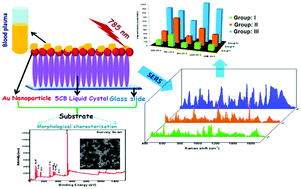Probing blood plasma samples for the detection of diabetes using SERS aided by PCA and LDA multivariate data analyses†
Abstract
The present paper reports the fabrication of an effective and reproducible SERS-active substrate for detecting individuals with “normal”, “moderately high” and “very high” diabetic conditions from the enhanced vibrational signatures of their respective label-free blood plasma samples. The SERS-active substrate has been fabricated by entrapping gold nanoparticles in the Langmuir-Reverse Schaefer film matrix of 5-CB liquid crystal molecules. The chemical composition of the as-fabricated substrate has been unveiled from the XPS spectrum, while the morphological features of the substrate are explored using FESEM and AFM images. The SERS efficacy of the substrate is primarily tested with 4-mercaptopyridine molecules. The experimental observations are supported by multivariate data analyses. The as-fabricated substrate is proved to have the unique efficacy to detect the SERS spectra of many types of molecules present in blood plasma samples, whose upregulation in diabetic patients is correlated with their glucose levels. We believe that the as-prepared SERS-active substrate can be used as a suitable alternative not only for detecting glucose levels indirectly from blood plasma samples but also in other real-world diagnostic applications.



 Please wait while we load your content...
Please wait while we load your content...